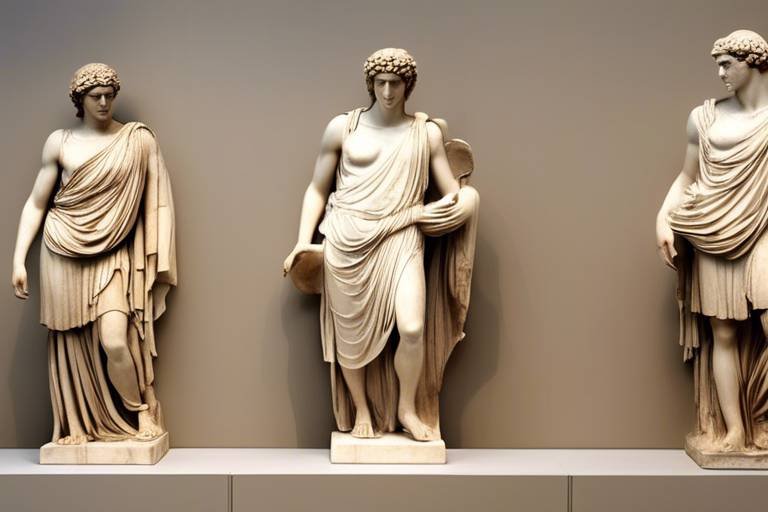The Influence of Ancient Civilizations on Modern Architecture
Throughout history, ancient civilizations have played a significant role in shaping the architectural landscape we see today. The influence of cultures such as the Greeks, Romans, Egyptians, Mesopotamians, Incas, Mayans, Asians, Africans, and indigenous peoples can be observed in the design principles and structural elements of modern buildings and urban environments. By delving into the architectural legacies of these ancient societies, we can gain a deeper understanding of how their innovative practices have stood the test of time and continue to inspire contemporary architects and designers.

Ancient Egyptian Influence
When exploring the influence of ancient civilizations on modern architecture, one cannot overlook the profound impact of Ancient Egyptian architectural elements. The legacy of the Egyptians is evident in the monumental entrances, massive stone construction, and symbolic ornamentation that continue to inspire contemporary architectural designs.
Ancient Egyptian architecture, characterized by its grandeur and symbolism, has influenced modern architects in creating structures that exude power and mystique. The use of massive stone blocks, such as in the construction of the pyramids, has inspired the durability and solidity seen in modern buildings.
Moreover, the monumental entrances of ancient Egyptian temples and tombs, adorned with intricate hieroglyphics and symbolic motifs, have influenced the design of modern building entrances, emphasizing the importance of creating a grand first impression.
The symbolic ornamentation found in ancient Egyptian architecture, including the use of obelisks, lotus flowers, and other sacred symbols, has been integrated into modern architectural designs to evoke a sense of history, spirituality, and cultural significance.

Greek Architectural Legacy
The legacy of ancient Greek architecture continues to shape modern building designs and urban landscapes in profound ways. The Greeks were pioneers in architectural innovation, introducing elements that have stood the test of time and influenced countless structures across the globe.
One of the most iconic features of Greek architecture is the column. The use of columns, particularly the Doric, Ionic, and Corinthian styles, has become synonymous with classical elegance and structural support. These columns not only provided essential structural integrity but also added a sense of grandeur and symmetry to buildings.
Furthermore, the Greeks valued symmetry and harmony in their architectural designs. The concept of balance and proportion was integral to their approach, leading to buildings that exuded a sense of order and beauty. This emphasis on symmetry can be seen in the facade of many modern buildings, where balanced elements create a visually pleasing aesthetic.
Another significant contribution of Greek architecture is the idea of public space. The Greeks were adept at creating communal areas that fostered social interaction and civic engagement. This concept has influenced modern urban planning, with public squares, parks, and gathering spaces playing a crucial role in city design.
Moreover, the Greeks were masters of architectural ornamentation. Intricate detailing, such as friezes, cornices, and pediments, adorned their buildings, adding a touch of artistic flair. These decorative elements have inspired modern architects to incorporate ornamentation into their designs, enhancing the visual appeal of structures.
In conclusion, the Greek architectural legacy is a testament to the enduring influence of ancient civilizations on modern architecture. By embracing principles of symmetry, harmony, and decorative embellishments, contemporary architects continue to pay homage to the timeless beauty and innovation of Greek design.

Roman Architectural Innovations
When it comes to architectural innovation and influence, the legacy of the Romans stands out prominently. The Romans were pioneers in engineering and construction, introducing revolutionary techniques that have shaped modern architectural practices. One of the most iconic Roman architectural innovations is the arch, a structural element that allowed for the construction of grand structures such as aqueducts, amphitheaters, and triumphal arches. The use of arches not only provided structural support but also added a sense of grandeur and elegance to Roman buildings.
Furthermore, the Romans perfected the art of building domes, creating vast interior spaces that were both functional and awe-inspiring. The Pantheon in Rome, with its massive dome and oculus, remains a testament to Roman ingenuity and architectural prowess. The use of concrete, a material developed by the Romans, enabled the construction of durable and long-lasting structures, laying the foundation for modern concrete construction techniques.
In addition to arches and domes, Roman aqueducts revolutionized the transportation of water in ancient cities, showcasing their advanced engineering skills. The Pont du Gard in France is a remarkable example of Roman aqueduct technology, demonstrating their ability to build complex water supply systems that relied on gravity to transport water over long distances.
The legacy of Roman architectural innovations can be seen in modern buildings and infrastructure around the world. From the use of arches and domes in contemporary architecture to the development of concrete as a primary construction material, Roman influence continues to shape the way we design and build structures today. Their emphasis on durability, functionality, and aesthetic appeal has stood the test of time, making Roman architectural innovations a timeless source of inspiration for architects and engineers alike.

Mesopotamian Architectural Contributions
Mesopotamia, often referred to as the "cradle of civilization," has made significant contributions to modern architecture through its innovative urban planning and architectural techniques. One of the most notable legacies of Mesopotamian architecture is the development of ziggurats, towering stepped structures that served as temples and focal points of cities. These massive brick constructions not only showcased the advanced engineering skills of the Mesopotamians but also influenced the design of religious buildings in later civilizations.
Furthermore, Mesopotamian architects were pioneers in the use of mud bricks as a primary building material, a practice that has endured over millennia and can still be seen in certain regions today. The durability and insulating properties of mud bricks allowed for the construction of sturdy buildings that could withstand the harsh climate of the region. The layout of Mesopotamian cities, with their grid-like street patterns and centralized public spaces, also set a precedent for urban planning that continues to influence modern city layouts.

Inca and Mayan Architectural Influence
When exploring the architectural influence of the Inca and Mayan civilizations on modern architecture, we encounter a rich tapestry of unique design elements and construction techniques that continue to inspire architects and designers today.
The Inca civilization, known for their advanced masonry skills, utilized finely cut stones to create intricate structures such as Machu Picchu. The precision of their stone work and the use of terraces for agricultural purposes have influenced contemporary architectural designs seeking a blend of functionality and aesthetic appeal.
Similarly, the Mayan civilization's architectural legacy is characterized by impressive pyramids and temples constructed with meticulous attention to detail. The Mayans' innovative use of stepped pyramids and complex geometric patterns has left a lasting impact on modern architectural aesthetics, inspiring architects to experiment with form and structure.
One striking aspect of the Inca and Mayan architectural influence is the emphasis on harmony with nature. Both civilizations integrated their structures seamlessly into the surrounding environment, showcasing a deep respect for the natural world. This eco-friendly approach to architecture resonates with modern sustainability efforts, prompting architects to consider the ecological impact of their designs.
Furthermore, the symbolic significance embedded in Inca and Mayan architecture, such as the alignment of buildings with celestial events or the incorporation of religious motifs, adds a layer of cultural depth to contemporary architectural creations. Architects today often draw inspiration from these ancient civilizations' spiritual connections to the built environment, infusing their designs with meaning and storytelling.
In conclusion, the architectural influence of the Inca and Mayan civilizations transcends mere aesthetics, offering a profound insight into the symbiotic relationship between human creativity and the natural world. By studying and honoring the architectural achievements of these ancient cultures, modern architects continue to push boundaries and redefine the possibilities of architectural design.

Asian Architectural Traditions
Asian architectural traditions have played a significant role in shaping modern architectural styles with their unique characteristics and rich cultural influences. From the intricate detailing in Chinese architecture to the spiritual symbolism in Indian designs, the architectural legacy of ancient Asian civilizations continues to inspire contemporary architects worldwide.
Chinese architecture, known for its emphasis on harmony with nature and intricate wooden structures, reflects a deep connection to traditional values and cultural beliefs. The use of wood as a primary building material, intricate carvings, and curved rooflines are distinctive features that have influenced modern architectural designs seeking a balance between aesthetics and functionality.
Japanese architecture, characterized by minimalist design, clean lines, and a focus on natural materials, embodies the concept of simplicity and tranquility. Traditional Japanese homes with sliding doors, tatami mat flooring, and Zen gardens showcase a harmonious blend of indoor and outdoor spaces, influencing modern architects in creating serene and contemplative living environments.
Indian architecture, with its rich history and diverse cultural influences, showcases a blend of intricate ornamentation, vibrant colors, and spiritual motifs. The use of intricate carvings, domes, and ornate details in structures like temples and palaces reflects the spiritual and cultural significance embedded in architectural designs, inspiring modern architects to incorporate symbolism and storytelling in their creations.
Each of these Asian architectural traditions brings a unique perspective and design philosophy that continues to shape modern architectural practices, emphasizing the importance of cultural heritage, craftsmanship, and sustainability in building design.

African Architectural Heritage
The architectural heritage of Africa is a rich tapestry woven with diverse influences and unique characteristics. From the mud-brick construction of ancient civilizations to the intricately designed thatched roofs of traditional villages, African architecture reflects a deep connection to the land and a harmonious relationship with nature. The use of locally sourced materials and sustainable building techniques has been a cornerstone of African architectural practices, ensuring structures that blend seamlessly with their surroundings.
One of the defining features of African architecture is the emphasis on communal living spaces, often centered around a courtyard layout. This design not only fosters a sense of community and togetherness but also provides natural ventilation and cooling in hot climates. The thatched roofs, with their natural insulating properties, are not only aesthetically pleasing but also practical in maintaining comfortable indoor temperatures.
Traditional African architecture also showcases intricate decorative elements, such as geometric patterns and symbolic motifs, that carry cultural significance and tell stories of the community's heritage. These embellishments are not merely ornamental but serve as a form of communication and expression, creating a visual language that is deeply rooted in tradition.

Indigenous Architectural Practices
Indigenous architectural practices around the world offer a rich tapestry of sustainable building techniques and cultural integration that inspire modern architects. Drawing from centuries-old wisdom and harmonious coexistence with nature, indigenous communities have developed innovative ways to construct dwellings that blend seamlessly with their surroundings. These practices often utilize natural materials like wood, stone, and clay, sourced locally to minimize environmental impact. The structures are designed to withstand the elements, adapting to climate conditions through clever ventilation systems, orientation towards the sun, and efficient use of space.
One notable example of indigenous architectural brilliance is the igloo, traditionally built by the Inuit people in the Arctic regions. These snow houses demonstrate exceptional thermal efficiency, providing warmth and shelter in extreme cold conditions. The dome-shaped structure not only offers structural stability but also reflects the deep connection between the Inuit culture and the environment. Similarly, the stilt houses of Southeast Asia, raised above water bodies to prevent flooding, showcase a harmonious relationship between architecture and nature.
Indigenous architectural designs often prioritize community living and social cohesion, with shared spaces and interconnected layouts fostering a sense of belonging and unity. The circular arrangement of dwellings in many indigenous settlements encourages interaction and collaboration among residents, promoting a strong sense of community identity. Moreover, the incorporation of cultural symbols and spiritual elements into architectural features adds layers of meaning and significance to the built environment.
These traditional practices not only offer valuable lessons in sustainability and resilience but also challenge modern architectural norms by emphasizing the importance of holistic design principles. By learning from indigenous architectural traditions, contemporary architects can imbue their creations with a deeper sense of cultural heritage, environmental consciousness, and social responsibility.
Frequently Asked Questions
- What are the key architectural elements that ancient civilizations have contributed to modern architecture?
Ancient civilizations like the Greeks, Romans, Egyptians, and Mesopotamians have influenced modern architecture through elements such as massive stone construction, columns, arches, ziggurats, and intricate detailing.
- How has ancient Egyptian architecture influenced modern building designs?
Ancient Egyptian architecture has inspired modern designs with its use of monumental entrances, symbolic ornamentation, and massive stone construction techniques, seen in various contemporary structures.
- What is the significance of Roman architectural innovations in modern construction?
Roman architectural innovations like arches, domes, and aqueducts have greatly influenced modern construction techniques, structural engineering, and the overall aesthetic of buildings and infrastructure.
- How have Asian architectural traditions impacted modern building styles?
Ancient Asian civilizations such as the Chinese, Japanese, and Indian cultures have influenced modern architecture through their use of wood, spiritual symbolism, and intricate detailing, shaping contemporary building designs.
- What role do indigenous architectural practices play in modern sustainable architecture?
Indigenous cultures worldwide have contributed to modern sustainable architecture by promoting the use of natural materials, sustainable building techniques, and integration with the environment in contemporary designs.


















